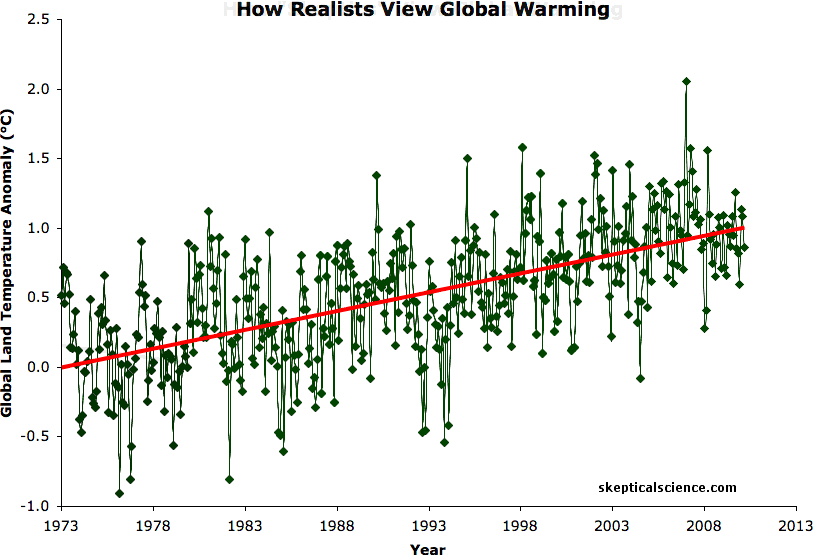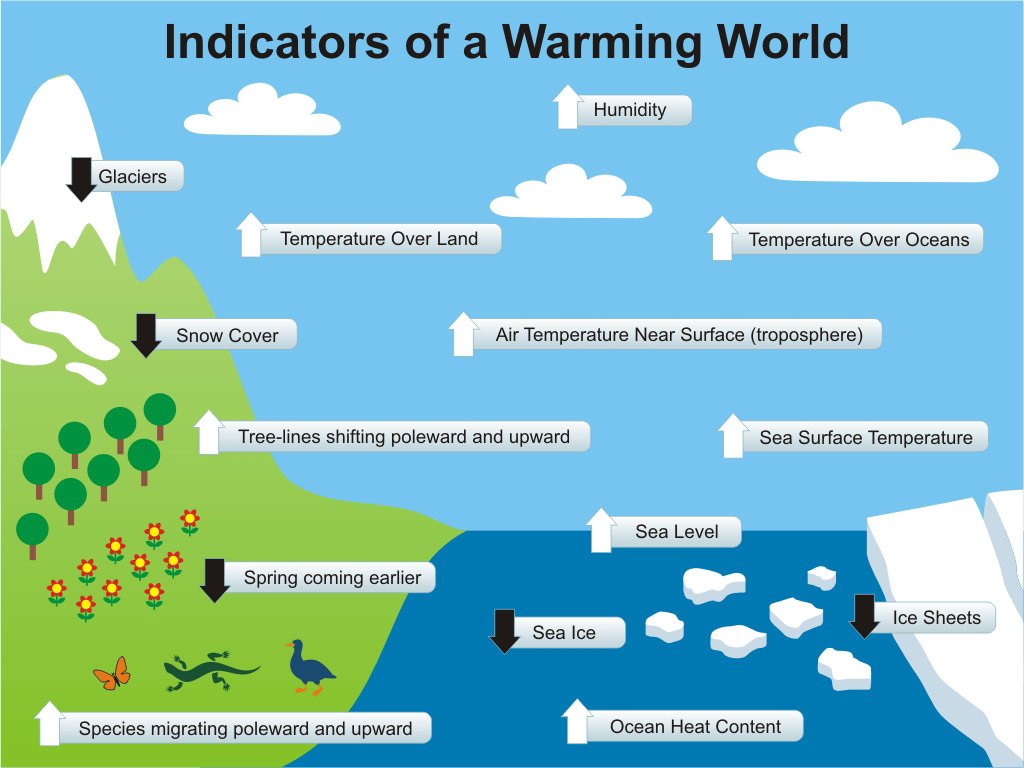Global Surface Temperature: Going Down the Up Escalator, Part 1
Posted on 5 November 2011 by dana1981
One of the most common misunderstandings amongst climate "skeptics" is the difference between short-term noise and long-term signal. In fact, "it hasn't warmed since 1998" is ninth on the list of most-used climate myths, and "it's cooling" is fifth.
This myth stems from a lack of understanding of exactly what global warming is. The term refers to the long-term warming of the global climate, usually measured over a timescale of about 30 years, as defined by the World Meteorological Organization. This is because global warming is caused by a global energy imbalance - something causing the Earth to retain more heat, such as an increase in solar radiation reaching the surface, or an increased greenhouse effect.
There are also a number of effects which can have a large impact on short-term temperatures, such as oceanic cycles like the El Niño Southern Oscillation or the 11-year solar cycle. Sometimes these dampen global warming, and sometimes they amplify it. However, they're called "oscillations" and "cycles" for a reason - they alternate between positive and negative states and don't have long-term effects on the Earth's temperature.
Right now we're in the midst of a period where most short-term effects are acting in the cooling direction, dampening global warming. Many climate "skeptics" are trying to capitalize on this dampening, trying to argue that this time global warming has stopped, even though it didn't stop after the global warming "pauses" in 1973 to 1980, 1980 to 1988, 1988 to 1995, 1995 to 2001, or 1998 to 2005 (Figure 1).
Figure 1: BEST land-only surface temperature data (green) with linear trends applied to the timeframes 1973 to 1980, 1980 to 1988, 1988 to 1995, 1995 to 2001, 1998 to 2005, 2002 to 2010 (blue), and 1973 to 2010 (red). Hat-tip to Skeptical Science contributor Sphaerica for identifying all of these "cooling trends."
As Figure 1 shows, over the last 37 years one can identify overlapping short windows of time when climate "skeptics" could have argued (and often did, i.e. here and here and here) that global warming had stopped. And yet over the entire period question containing these six cooling trends, the underlying trend is one of rapid global warming (0.27°C per decade, according to the new Berkeley Earth Surface Temperature [BEST] dataset). And while the global warming trend spans many decades, the longest cooling trend over this period is 10 years, which proves that each was caused by short-term noise dampening the long-term trend.
In short, those arguing that global warming has stopped are missing the forest for the trees, focusing on short-term noise while ignoring the long-term global warming signal. Since the release of the BEST data which confirmed the global warming observed by all other global temperature measurements, climate "skeptics" have been scrambling for a way to continue denying that global warming is a problem, and focusing on the short-term noise has become their preferred go-to excuse.
The Noisy Group
Unfortunately, those making a lot of noise about the noise (and sweeping generalizations that global warming has magically stopped) include several "skeptic" and/or "lukewarmer" climate scientists, who really should know better. One of these, Judith Curry, is actually a member of the BEST team whose data has been used by climate "skeptics" as "proof" that global warming has stopped. Unfortunately, Dr. Curry herself fed these myths in a rather dismaying interview:
"There is no scientific basis for saying that warming hasn’t stopped...To say that there is detracts from the credibility of the data, which is very unfortunate...This is “hide the decline” stuff. Our data show the pause, just as the other sets of data do. Muller is hiding the decline"
Predictably, Dr. Curry's comments have been disseminated far and wide by climate "skeptics" who desperately want this myth to be true.
Dr. Roger Pielke Sr. has made similar claims in the comments on Skeptical Science:
"Since 2002, as shown in the lower tropospheric plot and in the upper ocean data, little of that heat has accumulated there. There is not enough melt of sea ice or glaciers to account for it there. "Global warming" has nearly stopped using these two metrics"
Dr. Roy Spencer has taken this argument to the extreme, claiming that based on one cool month in his University of Alabama at Huntsville (UAH) tropospheric temperature dataset, "the troposphere is ignoring your SUV" and that (perhaps sarcastically):
"While any single month’s drop in global temperatures cannot be blamed on climate change, it is still the kind of behavior we expect to see more often in a cooling world"
These climate scientists really should know the difference between short-term noise and long-term signal, and it's a travesty that they're misinforming the public, the media, and policymakers by conflating the two concepts.
The Signal Comes Through Loud and Clear
On the other hand, other scientists who understand statistics are doing an excellent job explaining the difference between signal and noise. For example, when asked if BEST showed that global warming had stalled over the last decade in response to the interview with Dr. Curry, Dr. Richard Muller (the BEST team lead) said:
“That’s incorrect...I mean, what they have done is an old trick. It’s how to lie with statistics, right? And scientists can’t do that because 10 years from now, they’ll look back on my publications and say, ‘Was he right?’ But a journalist can lie with statistics. They can choose a little piece of the data and prove what they want, carefully cutting out the end. If I wanted to do this, I could demonstrate, for example, with the same data set that from 1980 to 1995 that it’s equally flat. You can find little realms where it’s equally flat. What that tells me is that 15 years is not enough to be able to tell whether it’s warming or not. And so when they take 13 years, and they say based on that they can reach a conclusion based on our data set, I think they’re playing that same game and the fact that we can find that back in 1980, the same effect, when we know it [was] warming simply shows that that method doesn’t work. But no scientist could do that because he’d be discredited for lying with statistics. Newspapers can do that because 10 years from now, nobody will remember that they showed that.”
What the Science Says
The peer-reviewed scientific literature confirms Muller's comments. For example, Santer et al. (2011):
"Because of the pronounced effect of interannual noise on decadal trends, a multi-model ensemble of anthropogenically-forced simulations displays many 10-year periods with little warming. A single decade of observational TLT data is therefore inadequate for identifying a slowly evolving anthropogenic warming signal. Our results show that temperature records of at least 17 years in length are required for identifying human effects on global-mean tropospheric temperature."
and Easterling and Wehner (2009):
"Numerous websites, blogs and articles in the media have claimed that the climate is no longer warming, and is now cooling....We show that the climate over the 21st century can and likely will produce periods of a decade or two where the globally averaged surface air temperature shows no trend or even slight cooling in the presence of longer?term warming."
Not only are these short-term "pauses" just noise in the data, but observations show that they are entirley expected, and predicted by climate models (i.e. see Meehl el al. 2011).
Other Physical Evidence of Continued Warming
It's also important to point out that global temperature measurements aren't our only evidence of the long-term global warming trend. We've observed many physical indicators of global warming (Figure 2).
Figure 2: Physical Indicators of a Warming World
When is Warming Cooling?
When constantly confronted with this myth that global warming stopped in 1998, or 2000, or 2002, or 2005, or [insert year], we wonder why distinguishing between short-term noise and long-term signal is such a difficult concept for climate "skeptics." They remind us of the Penrose stairs made famous by M.C. Escher - a staircase which people can descend forever and not get any lower. This paradoxical perception of an impossible construction seems to be how climate "skeptics" view the world, which is undoubtedly why they're willing to risk our future on the hopes that 97% of climate scientists are wrong about climate science.

Part 2 of this post examines the "skeptic" explanation of how these cooling periods can add up to a net warming, and why that explanation is physically incorrect.
Note: this post has been incorporated into the rebuttals to "global warming stopped in [insert year]", and Figure 1 has been added to the SkS Climate Graphics Page































 Arguments
Arguments
































With that, she plays a very delicate game of semantics. The words 'pause' and 'stop' confuse the question. Anyone who hears the superficial 'warming stopped' does not hear the following 'because of a relatively large short term variation' and takes away only the carefully crafted message. If she agrees that "identifying an AGW signal on this short timescale isn’t useful," then she must agree that saying 'warming stopped' due to a short-term variation is a misrepresentation. All she can claim is that the short term variation is indeed large enough to mask the ongoing rise and make it appear to cool for a few years - something we see clearly demonstrated in the animation in Figure 1 in this post. But to imply this short variation is a 'pause' or 'stop' in the long term trend is an overreach. It is akin to Pielke's 'the trend has changed' based on a few years. What of all the past 'pauses' or 'stops'? Did warming stop each time? Suppose that your route up a mountain includes a detour down a small valley where you camp for the night. The next morning you continue climbing. Curry and Pielke would describe the overnight as 'climbing has stopped'. That would give the casual observer the incorrect message that you might be on your way down. Such an ambiguous (and false) report could delay a rescue team from reaching your correct position. But perhaps that's the reason for these semantic debates; look how much effort has to be spent attempting to set it right. Bravo to tamino for calling her out in front of her own denizens. When she’s asked point-blank for the scientific basis of her claims she changes the subject. When she’s shown the error of her ways she refuses to admit it. Science by pronouncement: As tamino says "It’s not a crime. It’s a sin."